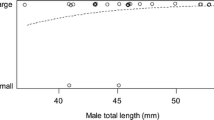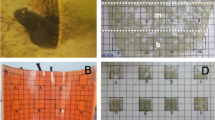Abstract
This study examines the temporal pattern of spawning behavior by the territorial (i.e. nest-holding) grass goby male, Zosterisessor ophiocephalus, in response to sneak intrusions by the small parasitic male under controlled laboratory conditions. The spawning activity of the territorial male consists of a sequence of upside–down movements on the ceiling of the nest accompanied by undulations of the body and sperm release. Five pairs of one territorial male and one parasitic male, each kept inside a large tank provided with an artificial buried nest (always occupied by the territorial male) and one small tunnel-shaped shelter (always occupied by the small male), were observed during one-female spawning taking place in the innermost part of the nest (i.e. the nest chamber). During the spawning, the presence of the small male nearby the nest openings elicited aggressive behavior and increased nest patrolling by the territorial male. In one spawn the small male never attempted to enter the nest. In four spawns the small male entered one to three times the nest chamber (sneaks), staying there from 2 to 203 s until the large male chased him away. The temporal patterning of the spawning activity by the territorial male (bouts of upside–down, U–D), and its changes following a sneak by the small male, were investigated using bout analysis and correlative tests. Results showed the length of bouts U–D did not change significantly after a sneak intrusion. whereas gap length (i.e. the period between subsequent bouts U–D) decreased significantly after each sneak intrusion. The mean duty cycle of bouts U–D tended to be positively correlated to the number of sneaker intrusions of each replicate. Results are discussed in the light of current knowledge on sperm competition among externally fertilizing teleosts.




Similar content being viewed by others
Explore related subjects
Discover the latest articles and news from researchers in related subjects, suggested using machine learning.References
Cole KS (1982) Male reproductive behavior and spawning success in a temperate zone goby (Coryphopterus nicholsi). Can J Zool 60:2309–2316
Fagen RM, Young DY (1978) Temporal patterns of behaviors: durations, intervals, latencies, and sequences. In: Colgan PW (ed) Quantitative ethology. Wiley, New York, pp 79–114
Haccou P, Meelis E (1992) Statistical analysis of behavioral data. Oxford University Press, Oxford
Kemadjou Nijwa JR, Muller P, Klein R (2004) Variations of sperm release in three batches of zebrafish. J Fish Biol 64:475–482
Magnhagen C (1992) Alternative reproductive behavior in the common goby (Pomatoschistus microps): an ontogenetic gradient. An Behav 44:182–184
Malavasi S, Lindström K, Sundström L (2001) Behavior and success of sneaker males in the sand goby, Pomatoschistus minutus. Acta Ethol 4:3–9
Malavasi S, Coppola J, Pranovi F, Granzotto A, Franco A, Torricelli P (2002) Habitat riproduttivo di Zosterisessor ophiocephalus Pall. (Pisces, Gobiidae) in laguna di Venezia e osservazioni sulle caratteristiche dei riproduttori. Lav Soc Ven Sc Nat 27:47–56
Marconato A, Rasotto MB, Mazzoldi C (1996) On the mechanism of sperm release in three gobiid fishes (Teleostei: Gobiidae). Environ Biol Fish 46:321–327
Mazzoldi C, Scaggiante M, Ambrosin E, Rasotto MB (2000) Mating system and alternative mating tactics in the grass goby (Zosterisessor ophiocephalus). Mar Biol 137:1041–1048
Ota D, Marchesan M, Ferrero EA (1996) Sperm release behavior and fertilization in the grass goby. J Fish Biol 49:246–256
Parker GA (1990) Sperm competition games: raffles and roles. Proc Royal Soc Lond B 242:121–126
Scaggiante M, Mazzoldi C, Petersen CW, Rasotto M (1999) Sperm competition and mode of fertilisation in the grass goby (Zosterisessorophiocephalus). J Exp Zool 283:81–90
Scaggiante M, Rasotto MB, Romualdi C, Pilastro A (2005) Territorial male gobies respond aggressively to sneakers but do not ad just their sperm expenditure. Behav Ecol 16:1001–1007
Siegel S, Castellan NJ (1992) Statistica non parametrica. McGraw-Hill, New York, p 477
Sokal RR, Rohlf FJ (1995) Biometry, 3rd edn. Freeman, New York, p 880
Stoltz JA, Neff BD (2006) Sperm competition in a fish with external fertilization: the contribution of sperm number, speed and length. J Evol Biol, 1873–1871
Torricelli P, Malavasi S, Novarini N, Pranovi F, Mainardi D (2000) Elongation of fin rays in parental males of Zosterisessor ophiocephalus. Environ Biol Fish 58:105–108
Acknowledgements
This study was supported by M.U.R.S.T. 60%.
Author information
Authors and Affiliations
Corresponding author
Rights and permissions
About this article
Cite this article
Malavasi, S., Lugli, M., Torricelli, P. et al. The nest-holding grass goby (Zosterisessor ophiocephalus) male adjusts the spawning activity in relation to parasitic nest intrusions. Environ Biol Fish 82, 279–287 (2008). https://doi.org/10.1007/s10641-007-9285-7
Received:
Accepted:
Published:
Issue Date:
DOI: https://doi.org/10.1007/s10641-007-9285-7




